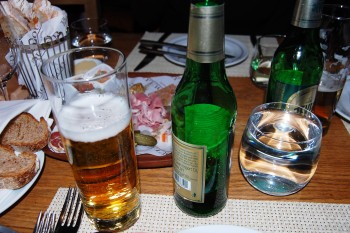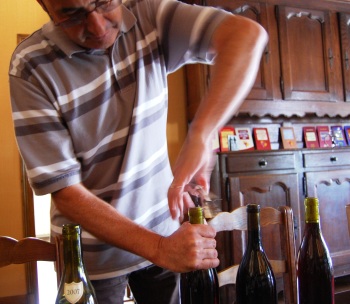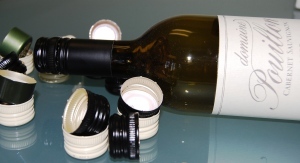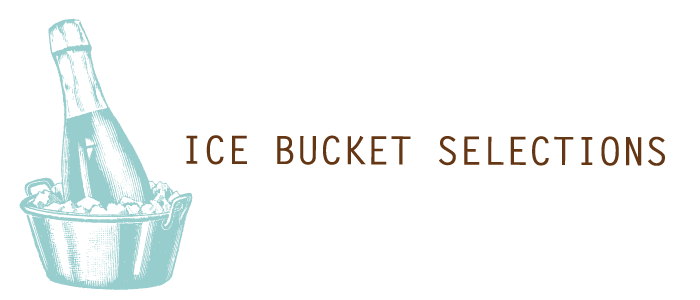SCREW 'DAT...OR TO TWIST OR TO PULL
 Thursday, January 7, 2010 at 03:07PM
Thursday, January 7, 2010 at 03:07PM 
Much too much has been written about wine bottle closures. Well, who am I to fight such a trend. So, here are my two cents.
Personally, a wine bottle could be stopped by a rag (preferably a clean one) and I'd be fine with it. As long as it didn't leak, that is. So, I think my two cents on this subject actually might have some perspective; I'm simply not vested in the way bottles are topped. (As an aside, I was twice offered trips to Portugal to visit a cork-making facility. Twice I demurred. I love Portugal, the wines, food, people, scenery, etc., so it should give you some sense of how little vested in the closure wars I am.)
Surprisingly, many people, including lots not tied to the bottle-closure industry, care about what's on top of that bottle. The reasons vary. Some think of it as an eco issue: Corks are natural products, screwcaps are not. Growing wine demand is putting cork trees under pressure, etc.
Others think it's a matter of style: How can a sommelier elegantly present a screwcap, after all? Still others are certain that screwcapped wines can't possibly age as well as cork-closed wines, therefore only cheap wine belongs in bottles thusly stopped.
 Most consumers make the assumption that screwcaps belong on cheap wine or beer (in the guise of a bottle cap).There may be others, but these are probably the main ones. And of them, thankfully, I only have an opinion about the last one. What is most interesting about the question of whether only super-cheap wine should be closed with screwcaps isn't so much whether that's true or not, but whether American consumers can handle the truth about the answer.
Most consumers make the assumption that screwcaps belong on cheap wine or beer (in the guise of a bottle cap).There may be others, but these are probably the main ones. And of them, thankfully, I only have an opinion about the last one. What is most interesting about the question of whether only super-cheap wine should be closed with screwcaps isn't so much whether that's true or not, but whether American consumers can handle the truth about the answer.
Let’s face it, Americans really have developed quite a thirst for wine in the last 20 years or so. But with that hankering comes the fear of being handed the wine list, a fear that seems to be part of our collective unconscious. In fairness to us, we don’t have the long history of wine on our tables that drinkers raised in the Old World do. There, wine is considered food, rather than an inebriant.
 Domaine Chapelle's Jean-François Chapelle opens his wines the traditional way. Screwcaps eliminate the need for elbow grease.It’s true that European consumption per capita is in the midst of a long decline, and that ours is going the opposite direction. But despite – or perhaps because of – the huge number of wine magazines, books, websites, “experts” conducting how-to seminars, etc., most consumers couldn’t tell the difference between a pinot noir and a pinot grigio. OK, that’s not quite true (hint just in case: one’s a red, the other’s not), but think about how otherwise fully functioning people are willing to rely on the advice of strangers when it comes to something they’re literally putting in their mouths.
Domaine Chapelle's Jean-François Chapelle opens his wines the traditional way. Screwcaps eliminate the need for elbow grease.It’s true that European consumption per capita is in the midst of a long decline, and that ours is going the opposite direction. But despite – or perhaps because of – the huge number of wine magazines, books, websites, “experts” conducting how-to seminars, etc., most consumers couldn’t tell the difference between a pinot noir and a pinot grigio. OK, that’s not quite true (hint just in case: one’s a red, the other’s not), but think about how otherwise fully functioning people are willing to rely on the advice of strangers when it comes to something they’re literally putting in their mouths.
I’m not even suggesting that people should know a lot about wine. I need to because I buy it and re-sell it to stores and restaurants. But most of you needn’t and shouldn’t be bothered. Not that there’s anything wrong with boning up so the next time you’re faced with hundreds of choices on a bunch of shelves, you can do more than pick a bottle according to label design or whether the wine name has one of the seven dirty words in it.
Back to the question of whether only bottom-shelf stuff belongs under screwcap. Did you know that the Aussies routinely close $100+ bottles in screwcaps? How could you, when most of those producers keep that stuff in Oz, choosing instead to send us “proper” cork-closed bottles? That’s changing – Wolf Blass was one of the first important producers to say enough already, when it began sending the big and bold (and expensive) Platinum and Black labels to us in screwcap a few years ago.
 Domaine Pouillon, located in Washington's Columbia River Gorge, uses screwcaps to close all its wines, an unusual move for a producer outside of Oceania.If screwcaps are good enough for WB (part of the mega-wine company Fosters; or did the name change again? I can’t – and won’t – keep track), then they should be good enough for you. While the jury may still be out on the long-term affect of screwcap versus cork in the aging process of a wine, the vast majority of bottles bought are going to be consumed that day anyway. And of the ones that won’t be, few are going to be left unopened for very long afterward.
Domaine Pouillon, located in Washington's Columbia River Gorge, uses screwcaps to close all its wines, an unusual move for a producer outside of Oceania.If screwcaps are good enough for WB (part of the mega-wine company Fosters; or did the name change again? I can’t – and won’t – keep track), then they should be good enough for you. While the jury may still be out on the long-term affect of screwcap versus cork in the aging process of a wine, the vast majority of bottles bought are going to be consumed that day anyway. And of the ones that won’t be, few are going to be left unopened for very long afterward.
Our screwcap aversion (I know there are more and more consumers who are not adverse any longer, but I’d bet the house that they are still in the minority of those who have a preference one way or the other) will continue for at least another generation.
I know I’m right, because the only way screwcap haters will stop the insanity is by losing their latent wine insecurity. And the only way wine list and retail shelf insecurity can be overcome is, as is the case in every field of insecurity, through education (or meds). So, some will twist open enough screwcapped bottles at various price points and realize that there is no noticeable difference (in fact, Chris Hatcher, a winemaker I respect a great deal, argues that whites will always be fresher, and therefore better, under screwcap) between their cork-stopped cousins. But most screwcap phobics will just continue on, oblivious to the truth.
Ignorance may be bliss, but it doesn’t taste as good.

